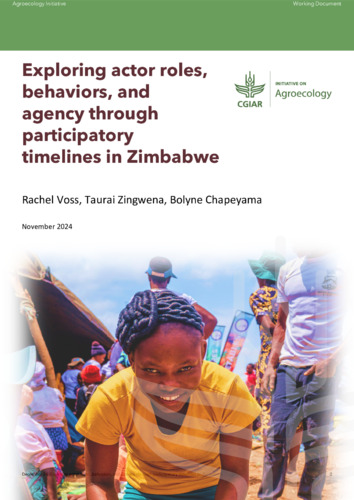Exploring actor roles, behaviors, and agency through participatory timelines in Zimbabwe
Abstract
This report highlights learnings from participatory timelines for agroecological transition conducted in Murehwa and Mbire Districts of Zimbabwe in 2022, and key informant interviews conducted from 2023-2024. Mbire’s timeline starting point was defined to be the tsetse fly aerial spray programs in the late 1980s, followed by rural resettlement and cotton promotion programs that contributed to a major expansion of agricultural and agropastoral activities. The region then saw a series of forest and wildlife conservation initiatives that promoted non-agricultural livelihoods alongside government programs supporting agricultural intensification. In the 2000s, government and NGO projects in the region focused on integrating conservation and agricultural production goals. In Murehwa, the starting point of the timeline was defined by Zimbabwe’s Fast Track Land Reform Program of the early 2000s, which redistributed land largely from white commercial farmers to black smallholders and medium-scale farmers, many of whom had previously farmed communal lands. This process pushed former farmworkers to begin clearing and farming previously conserved land. While it expanded new landowners’ agency, many lacked adequate resources and knowledge to productive farm their new land. In the following decades, government and NGO projects emphasized low-cost, resource-efficient practices such as conservation farming. The timelines highlighted the varied experiences of actor groups, including different types of farmers (smallholders, commercial farmers, landless workers, women). The land reform process affected these groups of farmers differently. Men were often more capable of benefitting from agricultural programs and projects than women due to their ownership of land and access to finance. However, women and youth have seen increased agency through empowerment programs. The timelines demonstrated incremental improvements in farmers’ knowledge about and uptake of sustainable practices and their agency to change their on-farm production systems. However, their involvement in governance and decision-making was modest throughout the timeline and remains low. Government actors, especially environmental agencies, local government bodies, and extension services, saw significant gains in agency and involvement in decision-making over the timeline, while traditional leaders lost power. International NGOs also gained de facto power over the agricultural development agenda as they provided crucial resources. Private sector actors played a relatively minor role in the timelines thus far, and barriers to their more active support of agroecological transition included unsupportive policies and a lack of consumer demand. These findings added breadth and depth to insights generated through previous WP5 activities and highlighted potential areas for change in AE-I implementation. These include supporting more transformational change through collective action, which could boost farmers’ involvement in broader decision-making and governance processes; monitoring farmers’ voice and agency, especially women and youths’, as important outcome indicators; and pursuing and formalizing partnerships with powerful government actors, influential civil sector actors, and private sector actors whose engagement has been modest but who have substantial potential for impact on behavioral outcomes.

